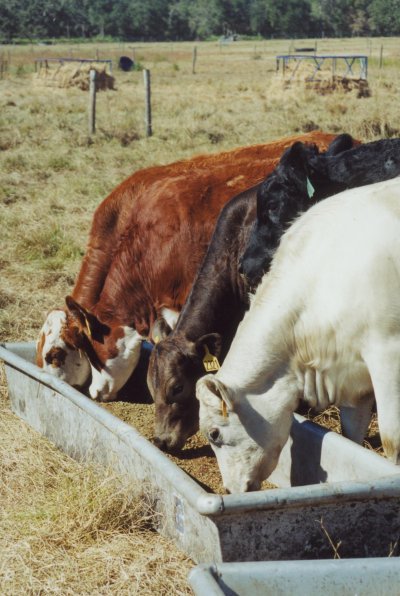Winter mineral supplementation: Opportunities for savings
Grazing cows have a nutritional requirement for minerals throughout the year. The concentration of mineral required in the diet often varies in relation to the cow's stage of production, predominantly pregnancy and lactation. The majority of a cow's mineral requirement is achieved through the consumption of forage. In some cases our pasture forages may supply the entire cow's requirement, but in the majority of cases some deficiency will result. The minerals that are most commonly found to be deficient in Florida forages include copper, zinc, selenium, cobalt, and sometimes phosphorus. If left unaddressed, deficiencies in these minerals can result in decreased growth of calves, decreased pregnancy rates, and an increase in health related problems. Mineral deficiency of forage is most often addressed by providing the cowherd free-choice access to a salt-based mineral supplement. In Florida, our mineral supplements are typically designed for a daily consumption of 2 to 6 ounces per cow. On average a quality mineral supplementation program can be provided for $12 to $16 per cow annually. Although this cost range is practical for most all production systems, it is not uncommon to find ranches that spend considerably more for annual cowherd mineral supplementation. These examples are typically the result of over-consumption of the mineral supplement. During the summer months the craving for salt typically causes cows to consume more mineral than targeted by the product formulation. In contrast, during the dryer winter months a decrease in mineral consumption is often observed. Over-consumption can be controlled by limit-feeding mineral to the cows once every seven days. If they consume their allotment within a couple of days, then mix stock salt at a 50:50 ratio until consumption is satiated to within 5 to 7 days. Be sure that the 50:50 ratio in inclusive of the salt and doesn't dilute the desired mineral consumption by 50%. It is not a problem to have the mineral feeder empty for a day or two until the next offering is provided. Over-consumption of mineral is too often mischaracterized by cowherd managers. They will suggest that this is simply "cheap insurance" to avoid the potential for mineral deficiency in the herd. This is an unfortunate consideration as extra mineral, consumed beyond the requirement of the cow, is usually expended in urine and feces and provides little to no added benefit. It is always best to attempt to capture this savings for use in more productive management applications, such as health care and energy and protein supplementation.
One simple method for realizing savings in the mineral supplementation program is through the use of commercial winter energy and protein supplements. Almost all commercial winter supplements (liquid molasses, cubes, mixed feed, and tubes or blocks) are fortified with minerals. When consumed in the suggested quantity, many of these commercial products will provide all the supplemental minerals needed by the cow. Therefore, no free-choice mineral supplement is required during the time that commercial feed supplements are provided. This advantage is further helpful for addressing the poor intake of free-choice mineral, which is often realized during the winter months.
When comparing the cost advantages of commodity byproducts versus complete feed supplements, the presence of added trace minerals is an important consideration. Although the unit costs relative to energy and protein may be less in the commodity byproduct the value of fortified nutrients in the commercial supplement may outweigh any cost advantage. It is important to realize that variation exists within individual commercial product formulations, so always ask the supplier about the need for additional mineral.



